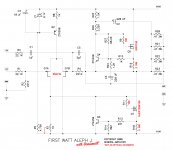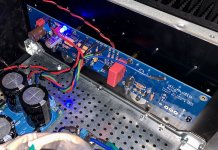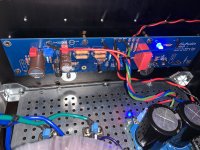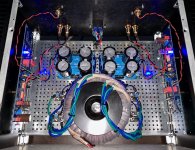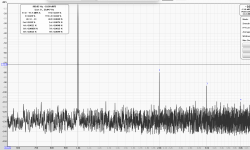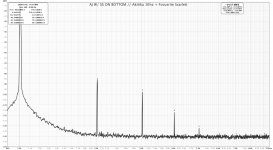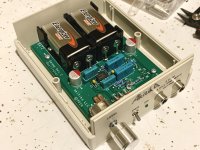Resurrecting this post to share my recently completed Aleph J SS.
After building (and loving) ZM's babelfish J2 with Semisouth parts, I got the itch to try them in a traditional Aleph build. The babelfish J2 is truly a pinpoint machine, as ZM puts it, and I was missing a bit of that warm midrange distortion I got from my stock AJ amp. I did some looking around and discovered this post and 6L6's Jango post. Since I didn't have matching parts and wasn't looking to parallel, I went with this option (though Jango is a much cooler name.)
As far as the build goes, I used the Store boards and modified slightly to fit my needs. Specifically this meant only one device in the top, current source position (an IRFP150) and one device on bottom (the veritable classic, SJEP120R100.) The store boards are convenient for this, as it already has a pot pinout for the the offset adjustment needed at the drain of the LTP. Keeping the store specified 2K pot works just fine. Note that the schematic earlier in this post omits the current protection on the output device, but I elected to keep it. Otherwise, its pretty much a 'by the book' AJ.
Part substitutions were minor. Dropping the parallel output devices meant I needed to beef up the source resistors to handle the extra heat. I considered just paralleling a couple 1R 3W MOX resistors, but ended up using those big Dale LVR 5 watt WW jobbies at .3R (I just like the look of them 🙂). I also dropped the gate resistors to 100R, mainly because I had a bunch on hand.
Well, it fired up just fine and sits at a rock steady 1.7A Iq. And it sounds FANTASTIC. Just like an AJ, except with some extra clarity and punch. Bass seems more firm and the highs a bit more clear. More cojones, if you will. As a comparison, my stock AJ build measured at around 0.055% THD. This things maintains the same distortion spectra, just less of it – about 18db lower across the board and a THD of 0.025%. (note – my current source dac is really noisy and measures about 0.012% THD on its own, so the totals in the screenshot aren't especially accurate)
I've attached a schematic of how I built mine, but please note that I'm not qualified to be doing any of this stuff. Take with a grain of salt. 😀
After building (and loving) ZM's babelfish J2 with Semisouth parts, I got the itch to try them in a traditional Aleph build. The babelfish J2 is truly a pinpoint machine, as ZM puts it, and I was missing a bit of that warm midrange distortion I got from my stock AJ amp. I did some looking around and discovered this post and 6L6's Jango post. Since I didn't have matching parts and wasn't looking to parallel, I went with this option (though Jango is a much cooler name.)
As far as the build goes, I used the Store boards and modified slightly to fit my needs. Specifically this meant only one device in the top, current source position (an IRFP150) and one device on bottom (the veritable classic, SJEP120R100.) The store boards are convenient for this, as it already has a pot pinout for the the offset adjustment needed at the drain of the LTP. Keeping the store specified 2K pot works just fine. Note that the schematic earlier in this post omits the current protection on the output device, but I elected to keep it. Otherwise, its pretty much a 'by the book' AJ.
Part substitutions were minor. Dropping the parallel output devices meant I needed to beef up the source resistors to handle the extra heat. I considered just paralleling a couple 1R 3W MOX resistors, but ended up using those big Dale LVR 5 watt WW jobbies at .3R (I just like the look of them 🙂). I also dropped the gate resistors to 100R, mainly because I had a bunch on hand.
Well, it fired up just fine and sits at a rock steady 1.7A Iq. And it sounds FANTASTIC. Just like an AJ, except with some extra clarity and punch. Bass seems more firm and the highs a bit more clear. More cojones, if you will. As a comparison, my stock AJ build measured at around 0.055% THD. This things maintains the same distortion spectra, just less of it – about 18db lower across the board and a THD of 0.025%. (note – my current source dac is really noisy and measures about 0.012% THD on its own, so the totals in the screenshot aren't especially accurate)
I've attached a schematic of how I built mine, but please note that I'm not qualified to be doing any of this stuff. Take with a grain of salt. 😀
Attachments
Looks great. Thanks for sharing.
Now I just need to find some spare Semisouth devices somewhere.....
Now I just need to find some spare Semisouth devices somewhere.....
This looks like fun.
Which power transformer are you using? Looks like it has four sets of secondary windings.
Which power transformer are you using? Looks like it has four sets of secondary windings.
This looks like fun.
Which power transformer are you using? Looks like it has four sets of secondary windings.
It’s the Antek 8420. Kind of a pseudo dual mono arrangement 🙂
I have same arrangement in Papa's Koan - 800VA Donut with 4x18Vac
had it on shelf for too long 🙂
had it on shelf for too long 🙂
Ha, I just stumbled over this thread. I also built an Aleph J with SemiSouth outputs. It's a great amp!
I used Zen Mods Babelfish J as a base, with the following changes:
About possible Babelfish J interest
Later on, I replaced R30 with a jumper. The SemiSouth parts don't need the compensation to avoid run-away. I can't say this made a huge difference, but I am not going back!
I used Zen Mods Babelfish J as a base, with the following changes:
About possible Babelfish J interest
Later on, I replaced R30 with a jumper. The SemiSouth parts don't need the compensation to avoid run-away. I can't say this made a huge difference, but I am not going back!
I have same arrangement in Papa's Koan - 800VA Donut with 4x18Vac
had it on shelf for too long 🙂
I really like the setup. Stays cool too
Later on, I replaced R30 with a jumper. The SemiSouth parts don't need the compensation to avoid run-away. I can't say this made a huge difference, but I am not going back!
I’ll look into this - thanks!
keep R16 at regular 0R47, decrease slightly R18, remove Q3
decide which combo you like more
I meant to ask - is there a performance increase to be had by dropping Q3? Or am I removing to accommodate the increased current from the resistor swap?
Q3 acts as a overcurrent protection, if you make a habit of shorting the speaker outputs you'll most likely take out the output stage. As to a benefit, not sure, I personally leave it out on every Aleph iteration i've built.
Do you happen to know when/how the overcurrent protection would be triggered?
ZM was suggesting I swap around source resistors to allow more current through the bottom half of OS. I knew Q3 was current limiting, so was curious if he suggested that change to accommodate the increase in current, or if it was considered a general performance improvement to remove the extra protection. I don’t make a habit of shorting the outputs, but I’d prefer not to remove unless there’s something to be gained.
ZM was suggesting I swap around source resistors to allow more current through the bottom half of OS. I knew Q3 was current limiting, so was curious if he suggested that change to accommodate the increase in current, or if it was considered a general performance improvement to remove the extra protection. I don’t make a habit of shorting the outputs, but I’d prefer not to remove unless there’s something to be gained.
Hi codyt,
I refer to the schematics you posted in #61. If I'm not misunderstanding things,
the current limit works by sensing the voltage across R18 (which is proportional
to the current through R18) This voltage is divided down by R13 and R14 and this
divided down voltage is limited by Q3 to a max of about 0.7V.
So with R13=221, R14=392 and max Vbe of 0.7V for Q3, we can back out a max
voltage drop across R18 of about 1,1V. So for R18=0.3ohm, the current limit
is a bit under 3.7 A.
As others have pointed out, this current limiter optionally can be omitted. Mr. Pass
also mentioned this in the Aleph reloaded thread:
https://www.diyaudio.com/forums/pass-labs/267857-aleph-design-reloaded.html#post4184920
I refer to the schematics you posted in #61. If I'm not misunderstanding things,
the current limit works by sensing the voltage across R18 (which is proportional
to the current through R18) This voltage is divided down by R13 and R14 and this
divided down voltage is limited by Q3 to a max of about 0.7V.
So with R13=221, R14=392 and max Vbe of 0.7V for Q3, we can back out a max
voltage drop across R18 of about 1,1V. So for R18=0.3ohm, the current limit
is a bit under 3.7 A.
As others have pointed out, this current limiter optionally can be omitted. Mr. Pass
also mentioned this in the Aleph reloaded thread:
https://www.diyaudio.com/forums/pass-labs/267857-aleph-design-reloaded.html#post4184920
I finally upped my measurement game and built an Akitika 2ppm 1Khz oscillator. Wow, makes a huge difference! I can definitely see all the junk my old source dac was putting in there. After some calibration and measurement, I can confidently say the Focusrite is contributing 0.003% to the THD. I measured the AJSS and feel like I got a more accurate picture. All said and done, we're looking at corrected THD of 0.025%. The standard AJ is listed at 0.05%, so the savings is consistent with Nelson's observations comparing the SS with the usual IRFP parts in the same circuits.
Here's a link to the Akitika. Took less than an hour to build, and its a pretty awesome piece of equipment! 1 kHz Oscillator
Next up, I'm going to install some pin sockets at the source resistor locations to play around with ZM's suggestions.
Here's a link to the Akitika. Took less than an hour to build, and its a pretty awesome piece of equipment! 1 kHz Oscillator
Next up, I'm going to install some pin sockets at the source resistor locations to play around with ZM's suggestions.
Attachments
I never installed the overcurrent protection in any of my builds...
Good job.
- Home
- Amplifiers
- Pass Labs
- Semisouth Aleph J?
